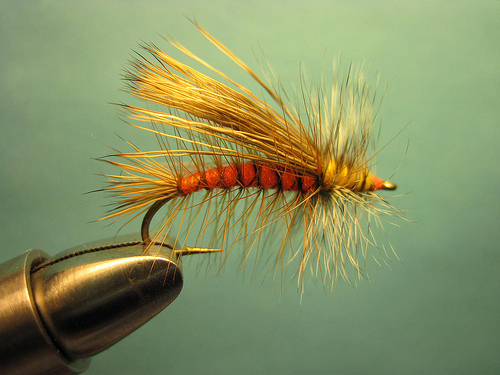Stimulator
Fall seems to have arrived, albeit with unusually warm conditions. The leaves ignore the temperature and change
anyway, painting the landscape with
bright reds and oranges, and muted yellows and browns. The streambed is littered with them, creating a kaleidescope
of sparkling color, especially when the
southerly sun is on the water and a breeze ruffles the surface.
At this time of year my dry fly thoughts turn to the Stimulator, at least where the October Caddis are hatching.
At certain times of the day, and when fished
properly, the Stimulator action can be fast and....well....stimulating.
This versatile fly is not only good for October Caddis; it can serve as a hopper in a pinch, or as a stonefly imitation.
Body and head color may vary, but the basic pattern is the same.
Randall Kaufmann is the inventor of this pattern. His specifications differ from what is laid out below, but the
materials I use are somewhat easier to come by than Kaufmann's and work just as well. I have selected the orange
color because of the October Caddis hatch which is occurring as we speak.
|
|
Instructions
1. Cover hook shank with thread.
2. Stack a small bunch of deer hair, and measure for tail; measurement should
equal gape of hook, not shank, since Stimulator tails are short.
3. Tie in deer hair just above back of barb. Tie down butts of deer hair, and trim
butts closely, at a taper.
4. Tie in the gold wire, at same point as tail was tied in.
5. Dub the body forward to a point just shy of the first 1/3 of the hook.
6. At the point where the body ends, tie in the ginger hackle. Since the hackle will
be palmered, tie it in shiny side facing forward.
7. Palmer the body back to the base of the tail, and let hackle pliers hang down,
thus holding the feather in place.
8. Carefully rib the body, weaving the gold thread through the hackle fibers. Tie
off ribbing at front of body. Do not build up excessive thread wraps.
9. Stack a small bunch of deer hair for the wing, which should extend to about
the bend of the hook. Secure the wing at the front of the body, taking care to keep
all of the hair on the top of the hook. When the wing is done, there should be
about 1/3 of the hook left in front of it for the thorax.
10. Trim off the butts of the hair at an angle and tie them down securely.
11. Tie in a hackle at the base of the wing, with the shiny side facing forward (just
the opposite of normal dry fly hackle methods).
12. Dub a nice fuzzy thorax, leaving enough room behind the eye for a nice
tapered head.
13. Wrap the hackle 3 or 4 times through the thorax, with the shiny side forward.
Tie the hackle off at front end of thorax.
14. Form a nice tapered head and whip finish
Fish this puppy high and dry, in against the bank, and hang on.
|

